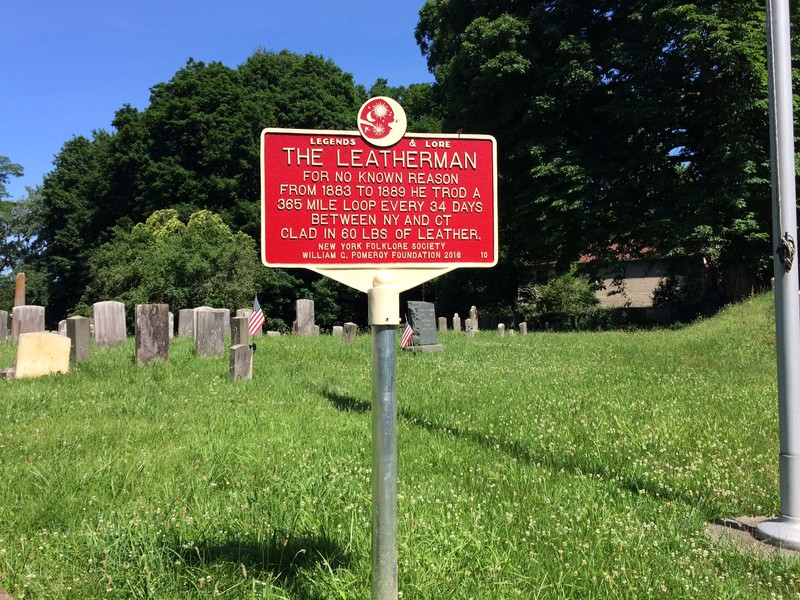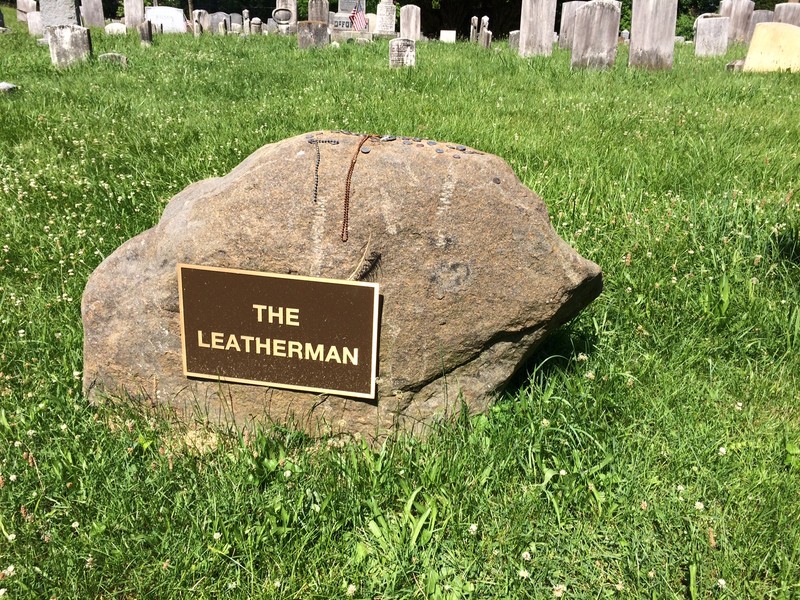The Leather Man
Introduction
Text-to-speech Audio
“Up the road he would come at a slow, steady pace, sometimes mumbling incoherently to himself, always accompanied by the rhythmic motion of his staff and the distinctive sound of heavy leather moving and rubbing together.”1 A stone boulder in Sparta Cemetery not far from the flag pole and inscribed with the words “The Leatherman” commemorates one of our areas most mysterious individual. From 1856 to 1889, dressed totally in leather, he regularly passed through communities in northern Westchester and southern Connecticut. Appropriately called the Leatherman, he became something of local celebrity. Attempts both during his life and after his death failed to determine his identity or the reason for his wandering lifestyle.
Images
The Leatherman

Leatherman Sign in Sparta Cemetery

The Leatherman Grave Marker

The Leatherman's Route

Backstory and Context
Text-to-speech Audio
The Leatherman first appeared around 1856 living off handouts from local families and sleeping in area caves and rock shelters. He soon became a routine sight on the roads in the area and adopted a roughly 365 mile circular route. In Westchester his route ran through the towns of White Plains, Armonk, Chappaqua, Briarcliff, Pound Ridge, Mount Kisco, Millwood, and North Salem. His was so consistent that newspapers published his itinerary and people claimed that you could set your clock by his appearance. Traveling roughly 10 miles a day, summer and winter, a complete circuit took him 34 to 36 days. His only concession to the weather was woolen underwear. It is interesting to mention that the blizzard of 1888, which killed hundreds and paralyzed transportation in New York City for two weeks, only altered his schedule by four days. He had regular stops at farms and houses along his route where he would accept gifts of food. “He would knock at the back door, place his hand to his mouth and mumble something.”3 “He took the food that was given him without comment other than to leave that which he did not want”4 wrote Elizabeth Fisher of Middletown CT. Coffee and tobacco were especially appreciated, but other items like clothing or money were usually refused. Offers of shelter, even in the coldest weather, were also generally not accepted. He preferred sleeping in the various caves and rock shelters where he stored bedding materials, firewood and occasionally kept a garden. Everything he owned he carried in a leather sack on his back.
He rarely spoke and answered most questions with grunts and gestures. Briarcliff resident, Walter L. Whitson, testified at the inquest into his death “I have known the Leatherman since I was a small boy. I often tried to get him into conversation, but he would never reply.”4Although some of the early news stories indicate people viewed him with distrust, he soon became something of a celebrity. His visits were eagerly anticipated. Housewives were known to cook special meals. He was often invited into homes to eat; and photographs of the Leatherman were included in the family albums. Children were warned to leave his shelters alone and not to annoy him because he might not return. On at least one occasion, local “hooligans” were arrested for harassing him. This incident made him alter his route and avoid the area. Several communities specifically exempted him from local vagrant laws.
Numerous newspapers published articles about the “Mystery of the Leatherman.” Who was he, and why had he adopted this particular lifestyle? Theories abounded. His name was reported to be Jules Bourglay, Jean Bourgeaurau, Zachiarias Boveliat, Randolph or Rudolph Masse. He was French, African American, Native American, Portuguese, or Canadian. Why did he constantly walk in an endless circuit through the countryside? People said his lifestyle was the result of a failed business deal, and/or a lost love, or he was a fugitive wandering to avoid the law. The most widely accepted romantic theory was that his name was Jules Bourglay of Lyons, France, and his solitary lifestyle and leather clothing were a penance for a failed business deal in the leather industry, which also cost him the love of his life. This story appeared in the Waterbury Daily American on August 16, 1884 and was later retracted, although it is still widely accepted. Briarcliff farmer, George Dell, one of the few people who claimed to have spoken to him, stated at the inquest, “I thought he was a Frenchman. I asked him a few words in French, and he answered promptly in French.”5 Over the years several attempts have been made to verify his identity. In 1938 Allison Albee of the Westchester County Historical Society sent letters to the American Consulate and French officials in Lyon and Marseilles to see if they could locate records of a Jules Bourglay, Bourglet, Bougeay or Bougeaurau. None were found. More recently, Leatherman researchers, Sarah and Roy Foote, again contacted authorities in France concerning Jules and received the same negative result.
In May 1888 people noticed a large tumor on his lip, which was making it difficult for him to eat. He was “arrested” in Connecticut by the Humane Society and taken to the Hartford Hospital to be treated. He refused treatment and was allowed to leave. On Sunday March 24, 1889 the Leather Man was found dead at one of his regular overnight stops in a rock shelter off Hillcrest Drive on the former Dell Farm in Briarcliff Manor not far from the intersection of the Old Chappaqua Road and the Taconic Parkway. Hundreds of people came to view his body at White & Dorsey’s Funeral parlor. He was given a funeral and placed in an unmarked grave at Sparta Cemetery in Ossining.
He no longer walked his solitary circuit of Westchester and Connecticut but interest in the Leather Man continued. During the 1930s Mrs. Edward Leikert, the daughter of George Dell, marked the location of the grave based on her memories of the funeral and in 1953 a headstone inscribed with the name Jules Bourglay was erected on that spot. In 2011, 120 years after his death, the Ossining Historical Society was granted permission to exhume the Leather Man and move his grave away from the roadway of Route 9. They also wanted to do a forensic analysis of the remains to see if science could shed any light on his identity. A team headed by Connecticut State Archaeologist Nick Bellantoni planned to exhume the body and take DNA samples. Unfortunately, there was no body. They were only able to recover a few fragments of a coffin and some rusty nails. The consensus was the acidity of the soil had destroyed his remains. The nails and surrounding soil were reinterred at a gravesite in the center of Sparta Cemetery with a new marker simply inscribed “The Leatherman.” Many people felt there is some justice in this because the Leather Man had a right to keep his secrets. According to Allison Albee, former member of the Westchester County Historical Society, “Never in history has so much been written about whom so little is known.”4 Who he was and why he choose his eccentric lifestyle are questions that still remain today. Newspaper and magazines articles are still written about him. Two documentaries are available on You Tube and in 1998 the rock group, Pearl Jam, wrote a song about him. Every year a 10k race called the Leatherman’s Loop is run in northern Westchester.
Footnotes
1. The Old Leather Man Historical Accounts of a Connecticut and New York Legend, Dan De Luca, Wesleyan Press, 2008, p. 112.
2. The Leather Man Part I, Allison Albee, The Westchester Historian (Vol 13:29-33, No 2) Westchester Historical Society, April 1937, p. 33.
3. The Leather Man Part I, Allison Albee, The Westchester Historian (Vol 13:29-33, No 2) Westchester Historical Society, April 1937, p. 33.
4. The Old Leather Man Historical Accounts of a Connecticut and New York Legend, Dan De Luca, Wesleyan Press, 2008, p. 111.
5. The Eccentric Circle – The Leather Man, Allison Albee, The Westchester Historian, (Vol 32:58-60, No3) Westchester Historical Society, Summer 1956, p. 58
Sources
Fetonti, Bob. The Leatherman, Briarcliff Manor Scarborough Historical Society. June 14th, 2014. Accessed July 7th, 2023. https://www.briarcliffhistory.org/the-briarcliff-notebook/the-leather-man-vol-14.
White, Dana. The Old Leather Man, Ossining Historic Cemeteries Conservancy. Accessed July 7th, 2023. https://www.ossininghistoriccemeteries.org/the-old-leather-man.
DeLuca, Dan. The Old Leather Man Historical Accounts of a Connecticut and New York Legend. Middletown, CT. Wesleyan Press, 2008.
Albee, Allison. The Eccentric Circle – The Leather Man. The Westchester Historian. Vol 32 No 3, Summer 1956.
Albee, Allison. The Leather Man Part I, II, III. The Westchester Historian. Vol 13 No 2, 1937
Risinit, Michael. "On the Trail of the Leather Man." Journal News March 27, 2007. .
Applebome, Peter . "Looking for Answers from a Wanderer at Rest." New York Times, March 3, 2011. .
Applebome, Peter . "Even after the Grave is Opened, Wanderer Stays a Mystery." New York Times, May 26, 2011. .
Clark, Rdie. Old Leather Man/A Connecticut Legend. Yankee Magazine. July 29, 2011
Cambell, Jon. "Mystery Man: Will Anyone Ever Know the Real Story Behind The Leatherman?." The Village Voice June 6, 2015. .
James Rogers
B Fetonti
B Fetonti
B Fetonti
